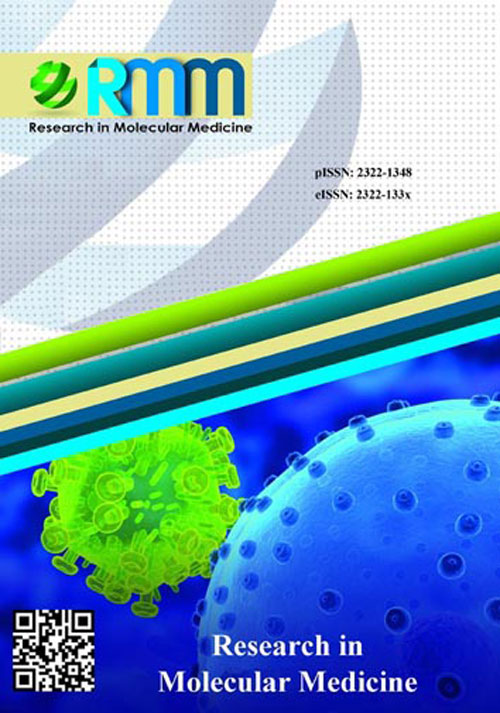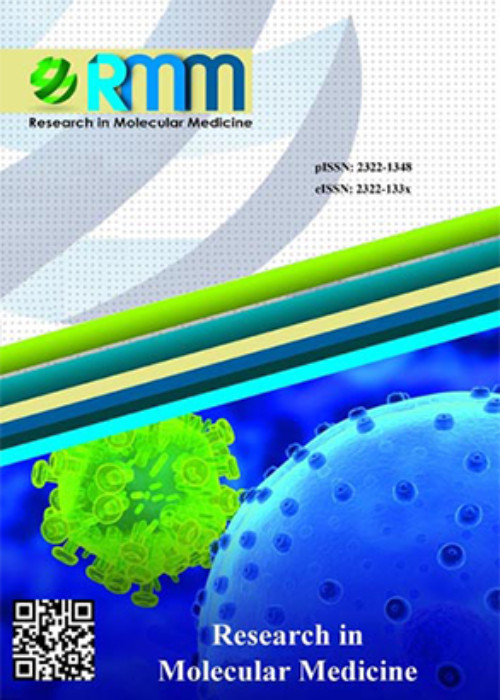فهرست مطالب

Research in Molecular Medicine
Volume:6 Issue: 4, Nov 2018
- تاریخ انتشار: 1397/08/10
- تعداد عناوین: 6
-
-
Pages 1-19Hydrogels have been used for biomedical applications in recent decades. They are a perfect candidate for regenerative medicine as they resemble the extracellular matrix of native tissues. In addition, their highly hydrated structure makes them a suitable choice for drug and other therapeutics delivery. Injectable hydrogels have increasingly gained attention due to their capability for homogeneous mixing with cells and therapeutic agents, minimally invasive administration, and perfect defect filling. In this review, we discuss various mechanisms which facilitate injectability of hydrogels, including in situ gelling liquids, injectable gels, and injectable particles. Then, we explore the biomedical applications of injectable hydrogels, including tissue engineering, therapeutic agent delivery, and medical devices.Keywords: Injectable, Hydrogel, In Situ Gelling, Tissue Engineering, Drug Delivery, Nanoparticle
-
Pages 20-27BackgroundThe most malignant form of infiltrating astrocytoma, glioblastoma multiforme (GBM), is one of the most aggressive human cancers. Foretinib diminished GBM cell invasion by downregulating the expression of matrix metalloproteinase 2 (MMP2). The study aimed to examine the anti-tumor activity of foretinib and to test its effect on MMP2 expression in T98 cells.Materials and methodsT98 cells were used as an experimental model of glioblastoma. The effect of foretinib on the expression of MMP2 was evaluated using quantitative real-time polymerase chain reaction. Thereafter, the effect of foretinib on the enzyme levels of MMP was examined by zymography. Statistical analyses were performed with GraphPad Prism software.ResultsA reduction in the expression of MMP2 was observed with an increase in the concentration of foretinib.ConclusionForetinib treatment leads to downregulation of MMP-2 and has a positive effect on T98 cells. We believe that foretinib can be subjected to further clinical investigation to develop a treatment for GBM.Keywords: Glioblastoma, foretinib, MMP-2, T98
-
Pages 28-37BackgroundYersinia pestis and Francisella tularensis cause plague and tularemia, which are known as diseases of the newborn and elderly, respectively. Immunological and culture-based detection methods of these bacteria are time-consuming, costly, complicated and require advanced equipment. We aimed to design and synthesize a gene structure as positive control for molecular detection of these bacteria.Materials and MethodsConserved regions of each bacterium were determined. A fragment containing the fopA and caf1 genes (conserved genes of F. tularensis and Y. pestis, respectively) was artificially synthesized, cloned into the pUC57 vector (pUC-fopA-caf1), transformed into E. coli DH5α, and used in a multiplex PCR assay. The sensitivity of this assay was examined by serial dilution of the extracted plasmid, whereas the specificity was examined using genomes of Escherichia coli, Salmonella typhi, Enterobacter aerogenes, Vibrio cholerae as templates. Finally, PCR products were analyzed in agarose gel electrophoresis.ResultsAs expected, our analysis showed a clear dual band in the size range of 107 bp to 176 bp, confirming the presence of fopA and caf1 genes. Another 351 bp band was detected due to amplification being dependent on the forward primer of fopA and the reverse primer of caf1. Optimization of the PCR protocol reduced the amplification of this 351 bp band. The sensitivity of this assay was determined to be 36×10 -3 ng/µl and the selectivity test confirmed the specificity of this method is appropriate for the detection of target genes.ConclusionThis multiplex PCR method could be used in research laboratories for identification of these important pathogens.Keywords: Francisella, Yesinia, Multipelex PCR, Detection, Positive Control Sample
-
Antimicrobial Effect of Multilayered Carbon Nanotubes on Multi-Drug-Resistant Pseudomonas aeruginosaPages 38-47BackgroundPseudomonas aeruginosa is the primary cause of infection with impaired defense mechanisms. P. aeruginosa commonly causes nosocomial infections and is the most common pathogen isolated from patients hospitalized for longer than 1 week. We examined the antimicrobial effect of multilayered carbon nanotubes on multi-drug-resistant.Materials and methodsIn this research, 20 clinical isolates collected at Motahari Hospital (Tehran, Iran) were compared with the standard (ATCC 27853) and identified as P. aeruginosa based on biochemical testing. Conventional disk diffusion assay demonstrated the methicillin resistance of the isolates. Minimal inhibitory concentrations for antibiotics and the multilayer CNTs were determined using the microdilution method. Single-walled CNTs were prepared and their efficacy and potential synergism with antibiotics was assessed.ResultsSynergism against P. aeruginosa was evident for methicillin + single-walled CNTs.ConclusionThe inhibitory effect of single-walled CNTs and methicillin was synergistic against the growth of P. aeruginosa.Keywords: antimicrobial, nanoparticle, multilayered carbon nanotubes, nanomedicine, Pseudomonas aeruginosa
-
Pages 48-58BackgroundBreast cancer is a hormone-dependent malignancy that is associated with estrogen and progesterone interactions. The liver is the most important organ to be affected by the metastasis of breast cancer, which causes functional impairment. We compared levels of obesity, 17β-estradiol, and secreted proteins in postmenopausal women with breast cancer but without hepatic symptoms to those in healthy postmenopausal women.Materials and methodsWe recruited 105 postmenopausal women with breast cancer but without any clinical hepatic symptoms based on a physician’s diagnosis, and 105 healthy postmenopausal women. After taking blood samples, we separated the serum and determined the levels of alanine aminotransferase (ALT), enzyme aspartate aminotransferase (AST), sex hormone-binding globulin (SHBG), and 17β-estradiol using an enzyme-linked immunosorbent assay (ELISA). The results were statistically analyzed using SPSS.ResultsThe mean ages of the subjects in the cancer and control groups were 60.88 ± 0.85 and 55.56 ± 0.81 years, respectively. The exception ages (p=0.002), body mass index (BMI) values (p=0.033), serum glutamic oxaloacetic transaminase (SGOT) levels/AST levels (p=3.1*10-4), serum glutamic pyruvic transaminase (SGPT) levels/ALT levels(p=0.001), SHBG levels(p=0.014), and 17β-estradiol levels(p=0.003) in the serum differed significantly between the groups. Moreover, the mean serum 17β-estradiol (E2) levels and weights were higher in the cancer group than in the control group. Nevertheless, the mean serum levels of synthetic liver enzymes (SHBG, ALT, and AST) were lower in the cancer group than in the control group.ConclusionIn general, the postmenopausal cancer patients had higher serum estrogen levels and BMIs than their healthy counterparts. Furthermore, the levels of liver enzymes apparently decreased in the cancer group, probably owing to liver malfunction.Keywords: Breast cancer, SGOT, SGPT, SHBG, 17β-estradiol
-
Pages 59-68BackgroundMultiple sclerosis (MS) is an autoimmune disease that causes chronic inflammation of the central nervous system. MicroRNAs (miRNAs) are small non-coding RNAs 19–24 nucleotides long, which are differentially expressed in different tissues. The role of miRNAs in MS remains unclear. We assessed miR-10a transcript levels in MS patients during recurrence and two months after relapse.Materials and methodsIn this case-control study, we used real-time PCR to examine miR-10a expression in the peripheral blood mononuclear cells of 60 patients with relapsing-remitting multiple sclerosis (RRMS), 30 during recurrence and 30 two months after relapse, and 30 healthy subjects who were referred to the MS Clinic of Kashani Hospital, Isfahan Province. In silico analysis was also performed on the validated miR-10a targets using miRTarBase.ResultsmiR-10a expression was higher in RRMS patients during recurrence and two months after relapse (p < 0.0001 and p < 0.0001, respectively) than in the healthy subjects. Furthermore, in silico molecular signaling enrichment analysis identified 12 mRNAs as validated miR-10a targets.ConclusionThe expression of miR-10a was elevated in patients with RRMS compared to healthy subjects, suggesting that miR-10a could be a potential biomarker for RRMS diagnosis.Keywords: Biomarker, miRNA, miR-10a, Multiple sclerosis


